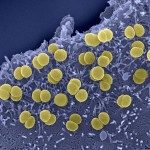Link to Pubmed [PMID] – 28379411
Link to DOI – 10.1093/femspd/ftx038
Pathog Dis 2017 07; 75(5):
The interaction of Neisseria meningitidis with both peripheral and brain endothelial cells is a critical event in the development of invasive meningococcal disease. In this study, we used in vitro models based on human brain microvascular endothelial cells (HBMEC), and peripheral endothelial EA.hy926 cells, to investigate their roles in the inflammatory response towards meningococcal infection. Both cell lines were infected with two pathogenic N. meningitidis isolates and secretion of the cytokine interleukin-6 (IL-6), the CXC chemokine IL-8 and the monocyte chemoattractant protein-1 (MCP-1) were estimated by ELISA. Neisseria meningitidis was able to stimulate the production of IL-6 and IL-8 by HBMEC and EA.hy926 cells in a time- and concentration-dependent manner. Interestingly, HBMEC released significant higher amounts of IL-6 and IL-8. Moreover, we observed that heat-killed bacteria stimulated high levels of IL-8. In addition, capsule expression had an inhibitory effect on IL-8 release. We extended our study and included serogroup C strains belonging to sequence type 11 clonal complex (cc) from a recent outbreak in France, as well as isolates belonging to the hypervirulent clonal complexes cc8, cc18, cc32 and cc269 and analyzed their ability to induce the secretion of IL-8 from both cell lines. Although individual variations were observed among different isolates, no clear correlations were observed between strain origin, clinical presentation and IL-8 levels.

